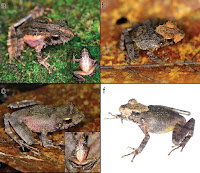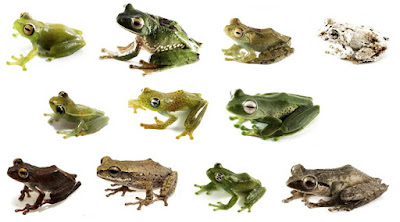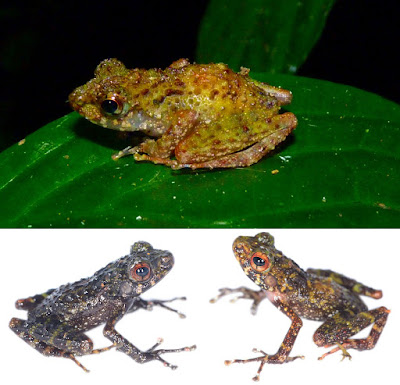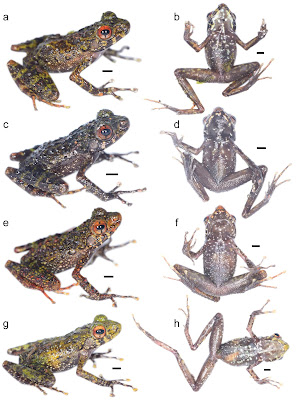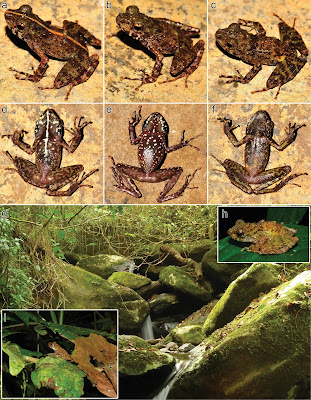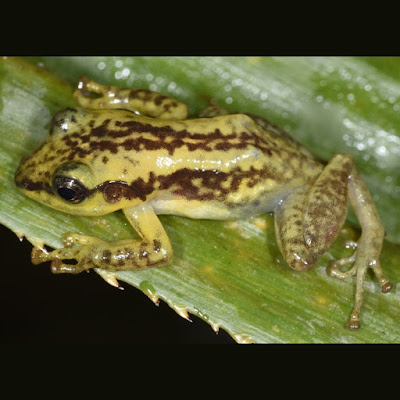 |
| Gephyromantis (Asperomantis) angano Scherz, Vences, Borrell, Ball, Nomenjanahary, Parker, Rakotondratsima, Razafimandimby, Starnes, Rabearivony & Glaw, 2017 DOI: 10.3897/zse.93.14906 |
Abstract
A recent study on a group of rough-skinned Gephyromantis frogs from Madagascar (Anura: Mantellidae: Mantellinae) established a new subgenus, Asperomantis, with five described species and one undescribed candidate species. Based on newly collected material from the Bealanana District, we address the taxonomy of this candidate species, and reveal that it consists of two populations with low genetic and morphological divergence but considerable bioacoustic differences that are obvious to the human ear. As a result, we describe some of the specimens formerly assigned to Gephyromantis sp. Ca28 as Gephyromantis angano sp. n. and assign the remaining specimens from a locality between Bealanana and Antsohihy to a new Unconfirmed Candidate Species, G. sp. Ca29. Gephyromantis angano sp. n. is a small species that strongly resembles G. asper and G. ceratophrys, but it differs from these and all other Gephyromantis species by a unique, clinking advertisement call. The new species may be highly threatened by habitat fragmentation, but at present we recommend it be treated as Data Deficient until more data are available to assess its distribution. We discuss the curious relationship between G. angano sp. n. and G. sp. Ca29, which we suspect may represent a case of incipient speciation. We also identify two additional new Unconfirmed Candidate Species of Gephyromantis based on sequence data from other specimens collected during our surveys in the Bealanana District.
Key Words: Amphibia, Bioacoustics, Incipient speciation, Candidate species, Mantellinae
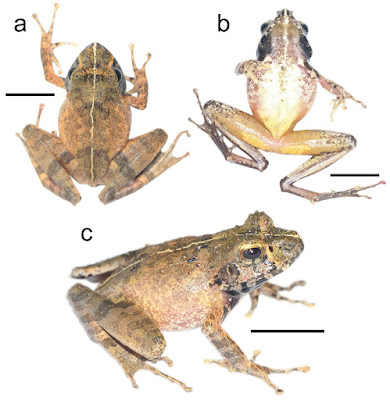 |
| Figure 5. The holotype of Gephyromantis angano sp. n., ZSM 68/2016 (MSZC 0172) in life in (a) dorsal, (b) ventral, and (c) lateral view. Scale bars indicate 10 mm. |
Gephyromantis (Asperomantis) angano sp. n.
Gephyromantis sp. Ca28 — Perl et al. (2014)
Diagnosis: A Gephyromantis species assigned to the subgenus Asperomantis based on the presence of small dermal spines on the elbow and heel, presence of inner and outer dorsal ridges as defined by Vences and Glaw (2001), Type 2 femoral glands sensu Glaw et al. (2000)Glaw et al. (2000), moderately enlarged finger and toe tips, absence of webbing between fingers, moderate webbing between toes, presence of paired blackish sub-gular vocal sacs in males, and a distinct whitish spot in the middle of the tympanic field (Vences et al. 2017). DNA sequence data from a fragment of the 16S gene supports this assignment. Gephyromantis angano sp. n. is characterized by the following suite of morphological characters: (1) adult SVL 29.1–30.5 mm, (2) TD/ED 0.61–0.71, (3) small supraocular spines, (4) large femoral glands consisting of numerous small granules, (5) moderately raised dorsal ridges, (6) granular dorsal skin, (7) relatively short hindlimbs (HIL/SVL 1.73–1.81 in males), and (7) its unique call (see above).
Within the subgenus Asperomantis, Gephyromantis angano sp. n. can be distinguished from G. ambohitra, G. spinifer, and G. tahotra by its smaller size (male SVL < 30 mm, vs. >31 mm, female SVL up to 30.5 mm vs. >32 mm); from G. spinifer by its less granular dorsal skin and smaller supraocular spines; from G. asper and G. ceratophrys by its generally shorter hindlimbs in males (HIL/SVL 1.73–1.81 vs. 1.77–2.11); and from G. ceratophrys by more granules per femoral gland (26–69 vs. 14–20). Bioacoustically, it is distinguished from all of these species by its call duration (41–98 ms vs. 5–44 ms in G. asper and G. ceratophrys, and 98–274 ms in G. ambohitra and G. tahotra), unpulsed calls (vs. pulsed in G. ambohitra and G. tahotra), calls repeated faster than in G. ceratophrys, and dominant frequency (3703–3875 Hz vs. 1435–3366 Hz in G. ambohitra, and G. tahotra).
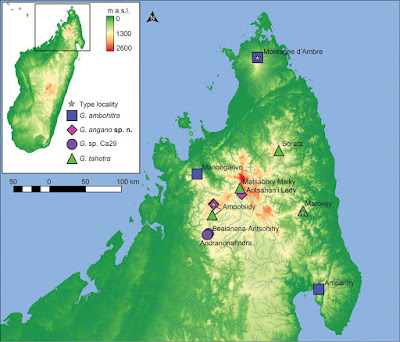 |
| Figure 7. Map of northern Madagascar indicating the known distribution of Asperomantis species. Colours correspond to species in Fig. 4. Three arc second SRTM basemap from Jarvis et al. (2008). |
Etymology: Angano is a Malagasy word meaning ‘fable’. The new material for this species was collected on Expedition Angano, a research expedition to the Bealanana District of northern Madagascar to assess the impacts of forest fragmentation on the reptiles and amphibians. The epithet is used as an invariable noun in apposition to the genus name.
Natural history and distribution: One specimen of this species has been collected in Antsahan’i Ledy, and numerous specimens of this species were encountered during fieldwork on the Ampotsidy mountains (Fig. 7). Calling males were generally found in association with slow flowing water, in the case of the holotype at the source of a spring, in close syntopy with Boophis madagascariensis and a Mantidactylus (Brygoomantis) species. Males called up to 1 m above the ground from fern fronds and other low foliage. Females were found both near to and away from water, during the day and at night, but were less commonly encountered. No eggs were observed, but highly ovigerous females were found in January (e.g. Fig. 6e). The call of the species is loud and carries over long distances, so that it can be heard alongside the calls of Boophis madagascariensis from well outside of some small forest fragments in the vicinity of Ampotsidy. In a small forest fragment where vouchers of Gephyromantis (Asperomantis) tahotra were collected (1368 m a.s.l.), G. angano sp. n. could also be heard; this appears to be the first ever record of any two Asperomantis species occurring in close syntopy (Vences et al. 2017).
Mark D. Scherz, Miguel Vences, James Borrell, Lawrence Ball, Denise Herizo Nomenjanahary, Duncan Parker, Marius Rakotondratsima, Elidiot Razafimandimby, Thomas Starnes, Jeanneney Rabearivony, Frank Glaw. 2017. A New Frog Species of the Subgenus Asperomantis (Anura, Mantellidae, Gephyromantis) from the Bealanana District of northern Madagascar. Zoosystematics and Evolution. 93(2); 451-466. DOI: 10.3897/zse.93.14906
---------------------------------------------------------------
روابط التحميل والمشاهدة، الروابط المباشرة للتحميل
او
شاهد هذا الفيديو القصير لطريقة التحميل البسيطة
كيف تحصل على مدونة جاهزة بآلاف المواضيع والمشاركات من هنا
شاهد قناة منتدى مدونات بلوجر جاهزة بألاف المواضيع والمشاركات على اليوتيوب لمزيد من الشرح من هنا
رابط مدونة منتدى مدونات بلوجر جاهزة بآلاف المواضيع والمشاركات في أي وقت حــــتى لو تم حذفها من هنا
شاهد صفحة منتدى مدونات بلوجر جاهزة بألاف المواضيع والمشاركات على الفيس بوك لمزيد من الشرح من هنا
شاهد صفحة منتدى مدونات بلوجر جاهزة بألاف المواضيع والمشاركات على الفيس بوك لمزيد من الشرح من هنا
تعرف على ترتيب مواضيع منتدى مدونات بلوجر جاهزة بآلاف المواضيع والمشاركات (حتى لا تختلط عليك الامور) من هنا
ملاحظة هامة: كل عمليات تنزيل، رفع، وتعديل المواضيع الجاهزة تتم بطريقة آلية، ونعتذر عن اي موضوع مخالف او مخل بالحياء مرفوع بالمدونات الجاهزة بآلاف المواضيع والمشاركات، ولكم ان تقوموا بحذف هذه المواضيع والمشاركات والطريقة بسيطة وسهلة. ــــــــــــــــــــــــــــــــــــــــــــــــــــــــــــــــــــــــــــــسلامـ.



